Kite: Japanese kamikaze
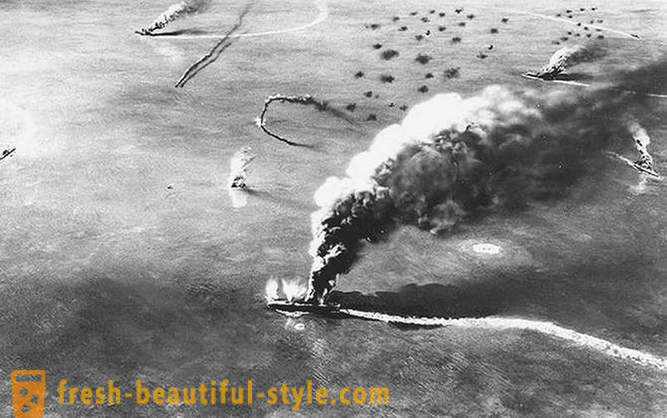
Popularized and highly distorted image of the Japanese kamikaze, which was formed in the minds of Europeans, has little to do with who they really were. We present the kamikaze as a fanatical and desperate warrior, with a red band around his head, a man with a furious look at the controls of an old aircraft carrier to the target with cries of "Banzai!". But suicide bombers were not only warriors air bombers, they operated under water. Preserved in a steel capsule - a torpedo-controlled kite bombers destroyed the Emperor's enemies, sacrificing himself for the sake of Japan and in the sea. On them will be discussed in today's material.
kamikaze School
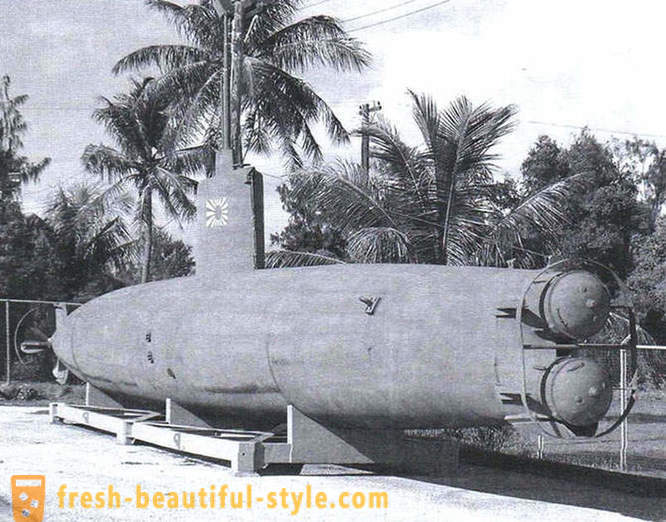
Before you go directly to the story of "live torpedoes" worth briefly dive into the history of the formation of schools and the ideology of suicide bombers.
The education system in Japan in the middle of the XX century differed little from the dictatorial schemes forming a new ideology. From an early age children were taught that dying for the emperor, they are doing the right thing, and their death will be blessed. As a result of academic practice, young Japanese have grown up with the slogan "jusshi reisho" ( "Donate Life").
Plus, the state machine in every possible way to hide any information about injuries (even the smallest) of the Japanese army. Propaganda has created a false picture of possibilities and Japan effectively inspired uneducated children that their death - a step toward total victory in the war Japan.
It is appropriate to recall the code of bushido, which played an important role in the formation of a kamikaze ideals. Japanese soldiers from the time of the samurai considered literally death as part of life. They get used to the fact of death and were not afraid to approach her.

Educated and experienced pilots flatly refused to go to the kamikaze units, referring to the fact that they are obliged to stay alive, to train new recruits, who are destined to become suicide bombers. Thus, the more young people to sacrifice themselves, the younger recruits were, took their places. Many were almost teenagers, not dostrigshim and 17 years who had a chance to prove their loyalty to the empire and manifest themselves as "real men".
Suicide bombers were recruited from poorly educated young men, second or third in the boys' families. The selection was due to the fact that the first (that is, older) boy in the family usually becomes heir to the state and therefore does not enter the military sample.
Kamikaze pilots received a form to fill out and took oath five points:
The soldier is obliged to fulfill its obligations.
The soldier is obliged to abide by the rules of decency in their lives.
The soldier is obliged to read highly the heroism of military forces.
A soldier has to be a moral person.
The soldier is obliged to live a simple life.
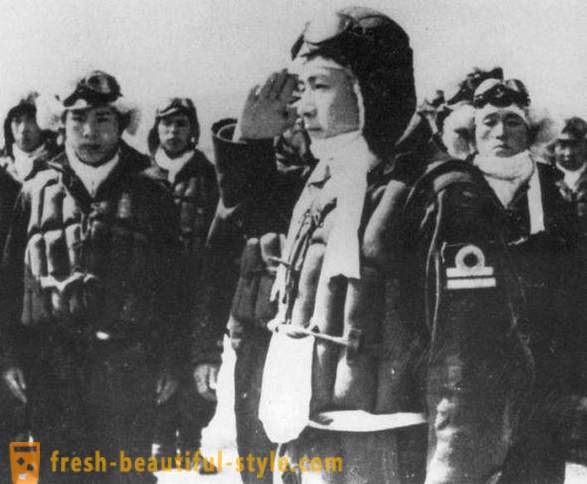
So unpretentious and just all the "heroism" kamikaze was reduced to five rules.
Despite the pressure of ideology and the imperial cult, not every young Japanese eager to accept with an open heart the fate of the condemned man who is ready to die for their country. In Kamikaze schools really queues of young guys, but this is only part of the story.
It's hard to believe, but even today there are still "live suicide bombers." One of them, Kenichiro Onuki, in his notes said that the young people could not join the groups Kamikaze, because it could bring trouble on their families. He recalled that when he "offered" to become suicide bombers, he took the idea of a laugh, but changed his mind overnight. If he dared not carry out the order, the most harmless, that it could happen - this is a brand "a coward and a traitor", and at worst - death. While all may be just the opposite for the Japanese. By chance, his plane did not wound up during the combat mission, and he was still alive. History of underwater kamikaze is not as funny as the story Kenichiro. It left alive.
Midueyskaya operation
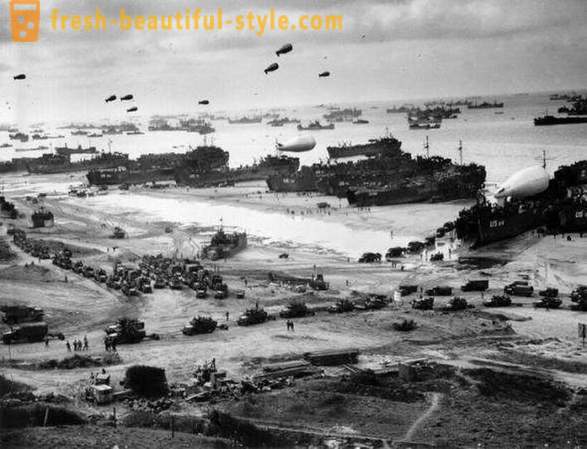
The idea of creating torpedoes suicide was born in the minds of the Japanese military command after a brutal defeat at the Battle of Midway.
While Europe's unfolding drama known world, in the Pacific Ocean was a very different war. In 1942, the Imperial Japanese Navy decided to attack Hawaii tiny Midway - extreme in the western group of the Hawaiian archipelago. Atoll US air base was located, with the destruction of which the Japanese army decided to start their own large-scale offensive.
But the Japanese miscalculated. The Battle of Midway was one of the main failures and the most dramatic episode in that part of the globe. When attacking the Imperial Fleet lost four large aircraft carriers and a number of other ships, but accurate data on casualties from the Japanese did not survive. However, the Japanese have never really thought of his soldiers, but without losing very badly demoralized the military spirit of the fleet.
This defeat marked the beginning of a series of failures in the Japan Sea, and the military command had to invent alternative ways of waging war. You should appear true patriots brainwashed, a gleam in his eyes, and not afraid of death. So there was a special experimental unit underwater kamikaze. These bombers were not much different from the pilots of aircraft, their task was identical - sacrificed himself to destroy the enemy.
From the sky into water
Underwater suicide bombers to carry out its mission under the water using a torpedo-kite, which translates as "the will of heaven." In fact, kite is a symbiosis of a torpedo and a small submarine. He worked in pure oxygen and was capable of speeds up to 40 knots, so that could hit almost any vessel at that time. Torpedo from within - this engine, powerful charge and a very compact place for a bomber pilot. In this case, it was so narrow that even for a small Japanese place lacked. On the other hand, what's the difference when the death is inevitable.
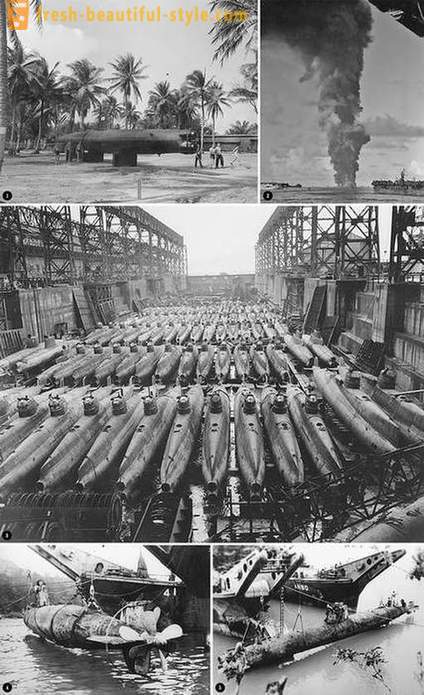
1. Japanese kaiten in Camp Dealy, 1945. 2. The burning ship USS Mississinewa, kite after falling into Ulithi Harbor, November 20, 1944. 3. kite in dry dock, Kure, 19 October 1945. 4, 5. The sinking of the US submarine aircraft during the Okinawa campaign.
Directly facing kamikadze periscope is near the speed change knob, which essentially regulated oxygen supply to the engine. At the top of the torpedo there was another lever, responsible for the direction of motion. The instrument panel was crammed with all sorts of devices - consumption of fuel and oxygen, pressure gauge, clock, depth, and so on. This driver leg is located a valve for the intake of seawater into ballast tanks to stabilize the weight of the torpedo. Manage the torpedo was not so easy, to the same pilot training left much to be desired - School appeared spontaneously, but as spontaneously and destroyed by American bombers.
Initially kaiten used for attacks on moored ships in harbors opponents. Submarine carrier with fixed outside kaytenami (four to six pieces) detecting enemy ships, to build a path (literally unfolded regarding the location of the target), and the captain of the submarine gave the final order bombers.
By narrow tube suicide penetrated into the cabin kite batten hatches to give instructions on the radio by the captain of a submarine. Kamikaze pilots were completely blind, they did not see where he was going, because the use of periscope could be no more than three seconds, as it led to a risk for detecting enemy torpedoes.
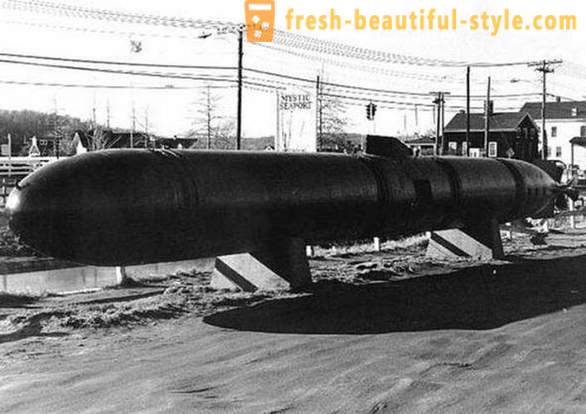
First kite terrified the American fleet, but then imperfect technique started to falter. A lot of suicide do not come to the shore to the target and suffocated from lack of oxygen, after which a torpedo sank. A little later, the Japanese have perfected the torpedo, providing her with a timer, leaving no chance of any suicide bombers or the enemy. But at the beginning of kaiten claim to humanity. The torpedo was provided ejection system, but it did not work most effectively, or rather not work at all. At high speeds, no suicide bombers would not be able to eject safely, so give it up in later models.
Very frequent raids submarine with kaytenami led to the fact that the apparatuses and rusted out of order, since the torpedo body was made of steel with a thickness not more than six millimeters. And if a torpedo sank too deep on the bottom, the pressure just to flatten a slim body and kamikazes died without proper heroism.
The failure of the project "Kaiten"

The first evidence of the attack kaytenov, recorded by the United States, dated November 1944. The attack involved three submarines and 12 torpedo-kaytenov against an American ship moored off the coast of Ulithi Atoll (Caroline Islands). As a result of attack one submarine sank just out of the remaining eight kaytenov two are out of order at the start, the two drown, one disappeared (although later was found beached) and one short of the target, exploded. The remaining kaiten crashed into the tanker "Mississineva" and sank it. Japanese High Command regarded the operation as a success, as was immediately reported to the emperor.
More or less successfully managed to use the kite at the very beginning. Thus, in the sea battle official propaganda Japan declared sunk 32 US courts, including aircraft carriers, battleships, freighters and destroyers. But these figures are considered too exaggerated. US Navy by the end of the war has significantly increased combat power, and the pilots kaytenov was harder to hit targets. Major combat units in bays securely guarded and steal up to him quietly, even at the depth was very difficult in the six meters, scattered attacks on the high seas ships in kaytenov as it was not possible - a long swim, they just could not stand. The defeat at Midway, the Japanese pushed to desperate measures in blind revenge the US Navy. Torpedo-Kite had a crisis solution, to which the imperial army had high hopes, but they did not materialize. Kite had to solve the main task - to destroy enemy ships, no matter what the price, but more and less effective envisioned their use in hostilities. An absurd attempt to irrational use of human resources has led to a complete failure of the project. The war ended with the total defeat of the Japanese, and the kite became another bloody thing of the past.












































